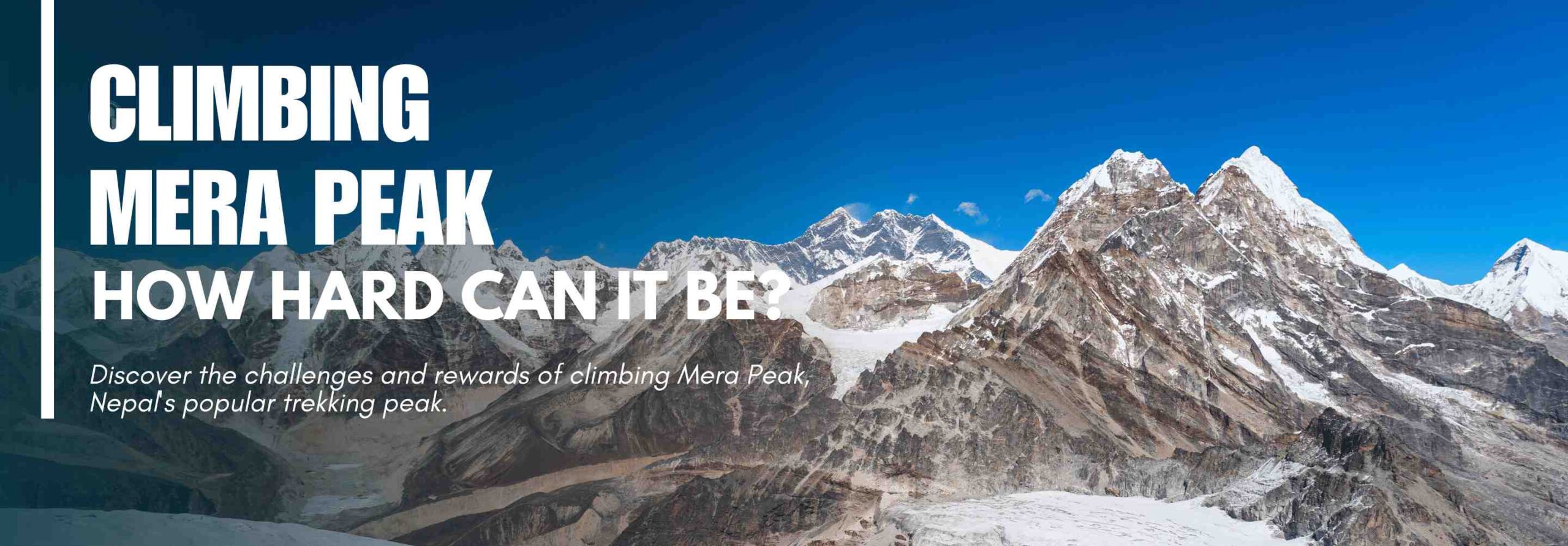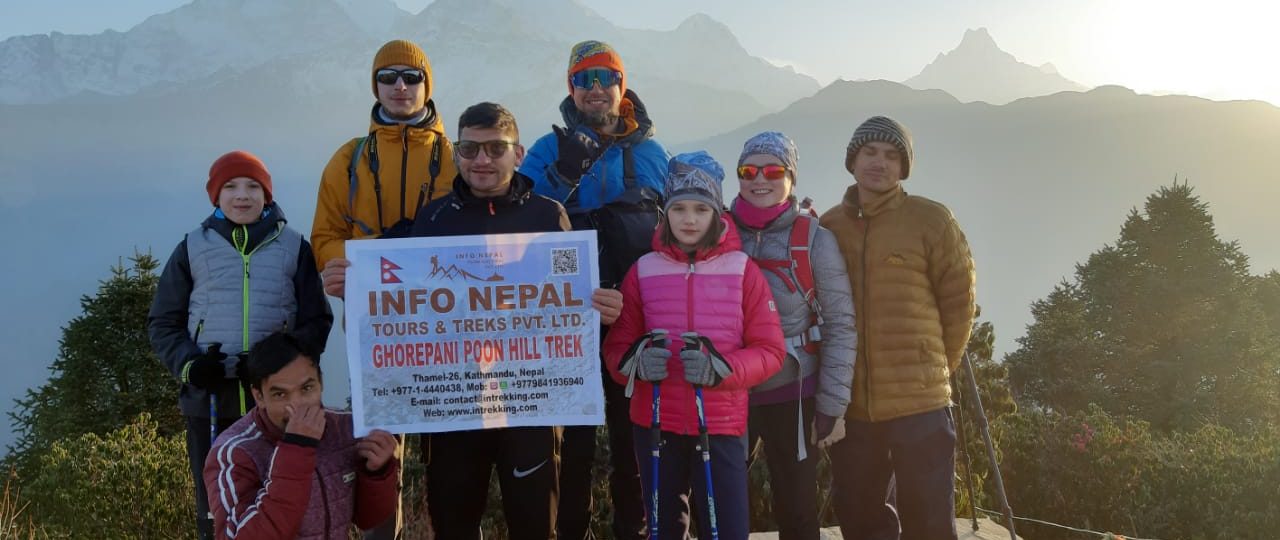
 Written By: Rajesh Neupane
Written By: Rajesh Neupane
How Hard Is Mera Peak Climbing?
Enquiry Form
Mera Peak (6,476m), one of the most Recognised peak in the Sagarmatha area, combines divine beauty and natural peace. The route goes up through picturesque Sherpa villages and lush woodlands, offering breathtaking views.
The normal route to Mera Peak is taken through Zatra La Pass, but you will follow the route south from Lukla, up the magnificent Hinku Valley, and then once again via Zatra La Pass. Mera Peak mountaineering is perfect for anyone with a modest mountaineering experience.
It is a challenging mountaineering peak due to the mountain’s elevation, even though the technical climbing abilities required are minimal. The summit welcomes you with incredible panoramas of the rising Nepal’s Himalayas, especially Mount Everest, Mount Lhotse Cho Oyu, the Kanchenjunga, and Makalu Peak.
On the Mera Peak journey, you will have a few nights overnight in camps in the open outdoors. You have to be confident setting up tents, skilled and proficient at maintaining your camp craft, and can maintain a high level of hygiene when camping.
Weather can be ferocious and test your limits as you move towards the peak. The Mera Peak journey will be a thrill for sure who is an adventure lover.
How hard is Mera Peak Climbing?
Of course, it’s a bit challenging! Peak mountaineering is an adventure of its own but the difficulty of climbing depends on the day’s weather, the nature of the climbing route, personal physical fitness and past climbing experience, climbing supplies, and other things. The Mera peak climbing route is typically off the beaten track.
Mera Peak Climbing is a difficult trekking peak due to its elevation, even though the technical climbing abilities required are minimal. There are many steps up and down, and the terrain is really difficult. When you climb further up Mera Peak, you enter the lower region of the death zone at 5,500 m. But with skilled Sherpa guides, you’ll be alright. Not a lot to think about.
Mera Peak Difficulty
According to the Alpine grading system, Mera Peak is classified as Alpine Grade PD, requiring technical climbing and challenging glaciers. Mera summit is a challenging summit to attain. While advanced technical climbing skills aren’t necessary, adventurers must be familiar with essential mountaineering techniques when trying to achieve the summit.
Don’t forget to equip yourself with suitable clothing for unique weather conditions, with waterproof clothes and insulated layering being critical throughout the year. We recommend using a proper safety guide and route maps, as the summit becomes more difficult as you mount the route. The body might experience trouble adapting to rising altitude.
Mera Peak Altitude
Mera Peak has mainly 3 summits i.e. Mera North (6,476m), Mera Central (6,461m), and Mera South (6,065m). Above 6400m, the oxygen content can be very low till 47%, and trekkers attempt the peak without supplementary oxygen, making the Mera peak a bit hefty to the summit.
Reaching the highest point of Mera Peak is a remarkable achievement. From the peak, you will have an amazing view of the world’s five tallest mountains: Mt. Everest (8,848 m.), Mt. Kanchenjunga (8,586 m.), Mt. Lhotse (8,516 m.), Mt. Makalu (8,481 m.), and Mt. Cho Oyu (8,188 m.). If you are an explorer, Mera Peak Climbing could be your defining moment.
Weather Condition
We find that the best month to climb Mera Peak as March-May. If you decide to climb in the month of early April or late October to November, you must be prepared for colder weather. Snow can fall during any of these months. As a result, you will need to adapt your gear and equipment to accommodate the colder weather conditions on the Mera Peak ascent.
Mera Peak Central and North Summit
The Nepal Mountaineering Association classifies Mera Peak into two summits: Mera Central and Mera North. Mera Peak’s top is recognised in both the central and northern directions.
Most groups tackle Mera Peak’s central summit of 6,461m, which is reached by ascending to the eastern top via a steep last 20m or so. Every outfitter offers the ascent of Mera Peak Central.
Mera North Summit 6,476m can be reached via a drop and traverse, which is beyond many people at this point. So we suggest taking a low path from the west and the move ahead for high camp for a steep rise to the summit.
Experience required to climb Mera Peak
Climbing Mera Peak requires great physical conditioning, and you can begin training in advance of your climb. You must be prepared to sleep several nights in a row in the wild outdoors.
Similarly, you must acclimatize appropriately during the journey and drink sufficient water to keep your body performing. Previous altitude experience can be quite beneficial for travel. Most guides offer climbing training in Khare prior to the actual climb, allowing you to master the fundamental mountaineering skills required for the climb throughout the trip.
Climbing Gears For Mera Peak
The right clothing, gear, and equipment are essential for any kind of journey to the peak, especially one like for Mera Peak. Crampons, ice axes, harnesses, carabiners, mounting packs, ropes, desender, jumpers, tapes, rappel devices and hand warmers are a few essential mountaineering gears for the adventure. You can buy them at Trekking Gear Nepal.
You must maintain your medical supplies, first aid kit box with oximeter, and pulse reader in the bag. Sleeping bags and tents are additional necessary gear as you could have to spend a couple of outdoor nights moving towards the summit. To stay in contact with the guides and family in an emergency, you want to carry reliable communication devices like an emergency satellite phone throughout the journey
Best time to Climb Mera Peak
Mera Peak is best climbed in the spring, from March to early May. It’s mountaineering season throughout the Himalayas. The weather is perfect, and the mountain views are breathtaking.
During the season of spring, the temperature in the lower elevations ranges around 10 degrees during the day and lowers to -4 degrees when the sun sets. The diverse flora and wildlife that surround the hospitable Sherpas community will warmly greet you. However, you can find weeks in June, December, August, and February that are optimal for touring.
Preparations for Mera Peak Climb
Long vertical climbs and several hours of descent in the mountains during terrible weather require a physically fit body. Before climbing the summit, your body must be properly acclimatized to the new environment.
Running, hiking, cycling, swimming, rock climbing, and practicing yoga before and throughout your journey will help you build your leg muscles, core strength, and upper body strength. These cardio-vascular activities will be very helpful on the journey to the summit.
If you have no prior climbing experience, the guides will walk you through hours of mountaineering instruction and Mera Peak climbing route conditions beforehand. Following these recommendations is essential for summiting the mountain safely.
Final Say
Mera Peak is one of the most popular peaks to summit in Nepal along the Everest region with beautiful views of 5 tallest mountains of the World Mt Everest, Mt.Makalu, Mt. Kanchenjunga, Mt. Lhotse and Mt. Cho Oyu.
Although the peak can turn out difficult for some adventure lovers, it is hefty and rewarding with its terrific mountain views and beautiful landscapes throughout the journey. Mera Peak is the dream destination for any mountaineer and adventure lover, just a single journey ahead.